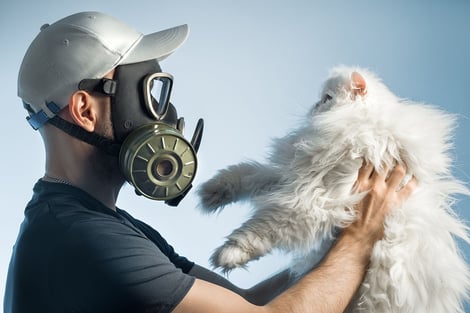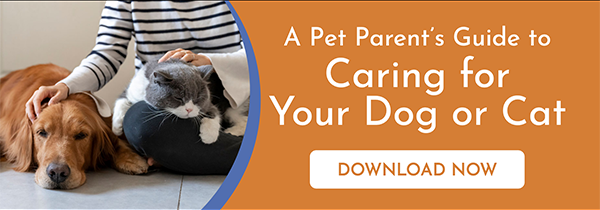Cats and Those Who are Allergic to Them

Allergies are annoying for people (and pets). But that doesn’t mean you have to get rid of a beloved cat if someone living in the home is allergic to them.
In 2013, The Ohio State University College of Veterinary Medicine’s Veterinary Public Health students developed tips for those who have allergies to common household pets.
What excites me is that since then, a special diet was developed for cats to help people who are allergic to them. If you don’t care about the science of this, that’s OK. You can try out the food by feeding your cats this special diet daily. It’ll take at least three weeks before this will help with any allergy symptoms.
Plus, cleaning your home at least once a week will be a high priority.
I’ve told a few people about this new diet, but I wanted to learn more about the science behind it.
That's why I attended a webinar called “Managing Cat Allergens & Improving the Human-Animal Bond.” presented by award-winning Dr. Michael Lapping, DVM, PhD, DACVIM at Colorado State University. He knows firsthand how to live (and work) with cats while being allergic to them.
Dr. Lapping told fellow veterinarians the science behind this new diet and discussed whether it actually works in the “real world” to help people have fewer allergic responses to their cats. I learned more than I thought I’d learn.
Why is the topic of people who are allergic to cats important?
- According to the APSCA, there are about 1.6 million cats dropped off at shelters by their owners
- 18% of cats are dropped off because people in the home had allergies to their cat
- 1 in 5 people is allergic to cats
For people who are allergic to their cats and don’t manage their symptoms very well, they can experience
- Tiredness
- Poor quality sleep
- Lower productivity & concentration
- Side effects of medications commonly used to reduce allergy symptoms
- Emotional toll of not being with their cats
Cats who live with people who are allergic to them can also have challenges
- They can’t spend time with the people they love
- Isolating the cat away from family members can cause stress for your cat, which may lead to diarhhea, bladder inflammation, and/or urinary tract infections
- This may be why a family member wants to take their cats to a shelter
- People who are allergic to cats don’t want to own or adopt them, even if they’d really love to have a cat
If you’re a science geek like me, you’ll want to know a little bit about the molecules that cause cat allergies.
- Allergens are molecules that can cause an allergic reaction
- Out of all the possible cat allergens tested, the one called Fel d 1 is the main allergen in cats
- Fel d 1 causes 95% of allergic reactions in people with cat allergies
- All cats produce Fel d 1 - All. Of. Them.
- Fel d 1 is found in cat saliva and sebaceous/oil glands (these glands are part of a cat’s scent-marking system)
- When cats groom themselves, they spread Fel d 1 on their fur and dander
- People who have allergies to cats can be exposed to Fel 1 d wherever cats spend their time, such as rugs, carpeting, chairs, couches, blankets, and beds
- People can also be exposed to Fel d 1 when petting a cat or if a cat licks their skin
If someone is allergic to one antigen, like Fel d 1, they’re commonly allergic to other antigens, like those produced by other animals.
Interestingly, a person doesn’t get allergic symptoms unless the number of total antigen molecules reaches a threshold level. That is, as long as the number of allergens is low enough, then you shouldn’t experience any allergy symptoms. This is known as the “principle of allergen load.”
Here’s the visual diagram that Dr. Lappin showed of what the principle of allergen load looks like, where A, B, C, and D are all different allergens. In this example, D represents Fel d 1 and the others are different allergens for an allergic person. Note that the amount of Fel d 1 a cat sheds are not dependent on the different seasons like pollen is.
So all that needs to happen to avoid allergic symptoms is to reduce the total number of allergens. If we decrease the number of Fel d 1 molecules, we’re “reducing the allergen load” and Voila! No more symptoms, as the image illustrates below.
Ways to reduce the allergen load in your home include
- Spay or neuter your cat - it can decrease the number of Fel d 1 molecules your cat sheds in their saliva or sebaceous/oil glands
- Keep a low number of cats in your home - cats don’t necessarily need other kitties in the home to be happy
- Wash your hands immediately after touching your cat with your bare hands
- Keep cats out of your bedroom or other places where you like to sleep
- If you and your cat can do this without a struggle, wash your cat up to once a week - use any shampoo made specifically for cats
- Reduce the number of rugs in your home or replace carpeting with wood, tile, linoleum, or other smooth surfaces - allergens love to hide out in rugs and carpeting
- Use high temperatures and detergent when washing bedding, clothing, and other washables
- Vacuum at least once a week - best if it has a HEPA filter
- Use a HEPA filter in household heating and cooling systems
- Use an air purifier with a HEPA filter where you like to spend time with your cat
- Use statically charged cleaning products (e.g., Swiffer) and/or clean with wet supplies like damp cloths or mops
- NOTE: If you’re the allergic one who has to clean the house, use a disposable dust mask while cleaning - keep in mind that cleaning can cause allergens to float into the air and it takes a few hours for those allergens to fall back down to the ground
- Allow your cat to go safely outdoors using a “catio” so it spends less time in your home
Now that you’ve learned more about allergies and ways to reduce the allergen load in your home, let’s talk about how a special diet can help decrease the allergen load of Fel d 1 in your cat’s saliva and sebaceous/oil glands.
- This special diet contains antibody molecules that bind to the Fel d 1 allergens
- When these special antibody molecules bind to Fel d 1, this allergen can no longer cause allergy symptoms.
- When the cat eats this special diet every day for at least three weeks, the number of allergens the cat produces goes down
If you truly want to have a cat in your home, and you or another family member is allergic to the cat, there are practical ways to keep your cat and be free of allergy symptoms.
Very exciting for kitties - and those who love them - everywhere.

